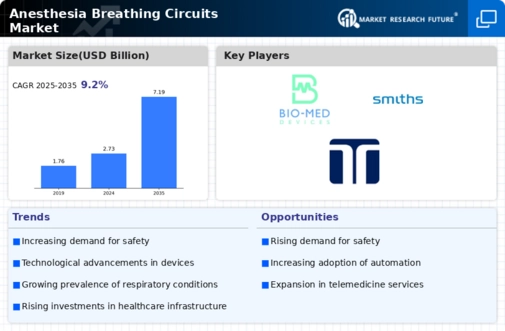Market Share
Anesthesia Breathing Circuits Market Share Analysis
The Anesthesia Breathing Circuits Market in the dynamic landscape of the healthcare industry uses various strategic market share positioning methods to gain a competitive edge. One of these is differentiation through technological innovation. Firms spend heavily on research and development so as to introduce state-of-the-art features that improve the performance and safety of anesthesia breathing circuits. By keeping themselves updated, these firms are able to attract medical practitioners who want modern solutions. Through that they could get many healthcare providers looking for high-tech solutions hence acquiring significant market share.
Also, customer-centric strategies have been adopted by most businesses operating in the Anesthesia Breathing Circuits Market. They make their products unique for every health care setting by understanding their needs well. For instance, customization, user friendliness or ease of use as well as compatibility with diverse anesthesia machines become primary selling points. This plan enables them not only retain customers but also attract others due to the increased demand for personalized systems in hospitals that can be easily integrated into their workflow.
Strategic partnerships and collaborations are another important part of market share positioning. In many cases alliances are formed by companies in the Anesthesia Breathing Circuits Market with some stakeholders like distributors and health care institutions among other partners so as to expand their reach. These enterprises increase their credibility by aligning with trustworthy associates while at the same time gaining access to broader networks of distribution. Consequently, it allows them entry into new markets thus increasing market shares leveraging on strengths and networks built with strategic collaborators.
An essential strategy employed by players in this case is price positioning within Anesthesia breathing circuits market. Some organizations focus on giving affordable options without compromising quality; targeting regions where budget constraints are serious considerations such as health centers or facilities in low-income areas for example smaller hospitals closer to rural areas. In price-sensitive markets, companies can command huge volumes through provision of reliable products at affordable prices especially if they can fill considerable gaps between popular manufacturers’ offerings and premium solutions. Alternatively, other firms that stress on sophisticated characteristics, superior materials or specific applications might charge premium prices for their products in order to benefit from a segment that is willing to pay more for quality goods.
Another important aspect of market share positioning is expansion into new territories. These companies usually concentrate on areas with high healthcare demand and an increasing focus on safety of patients. By establishing strong presence in major geographical regions, firms can take advantage of the growing use of anesthesia procedures through access to emerging markets. Furthermore, localized manufacturing and distribution also lead to cost efficiencies and faster response times further cementing a firm’s position within the market.
Moreover, striving for regulatory compliance while adhering strictly to quality standards is critical. Because equipment used in anesthesia are essential in-patient care, health providers usually prefer units that meet stringent regulatory benchmarks. Through this approach global certifications can be acquired therefore making it possible for companies from this sector act as reliable healthcare partners and trustworthy suppliers based on their commitment to quality which is helpful not only towards retention of existing customers but also gaining confidence from the new entrants joining the industry.







Leave a Comment